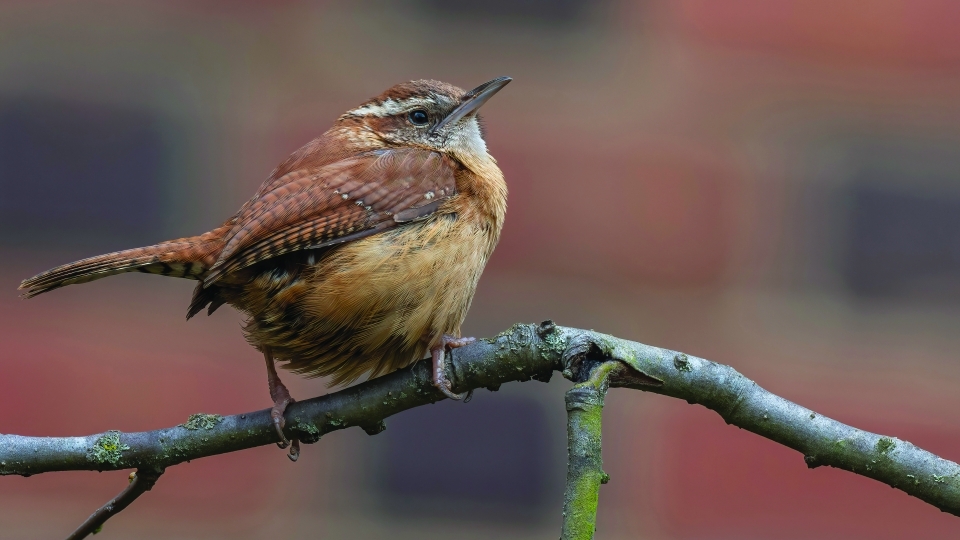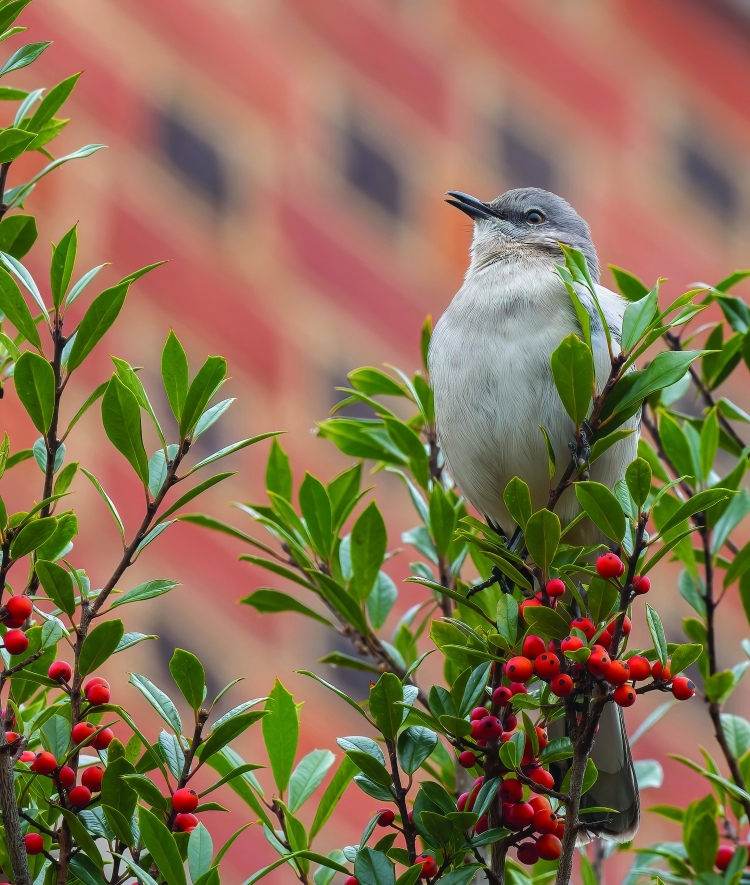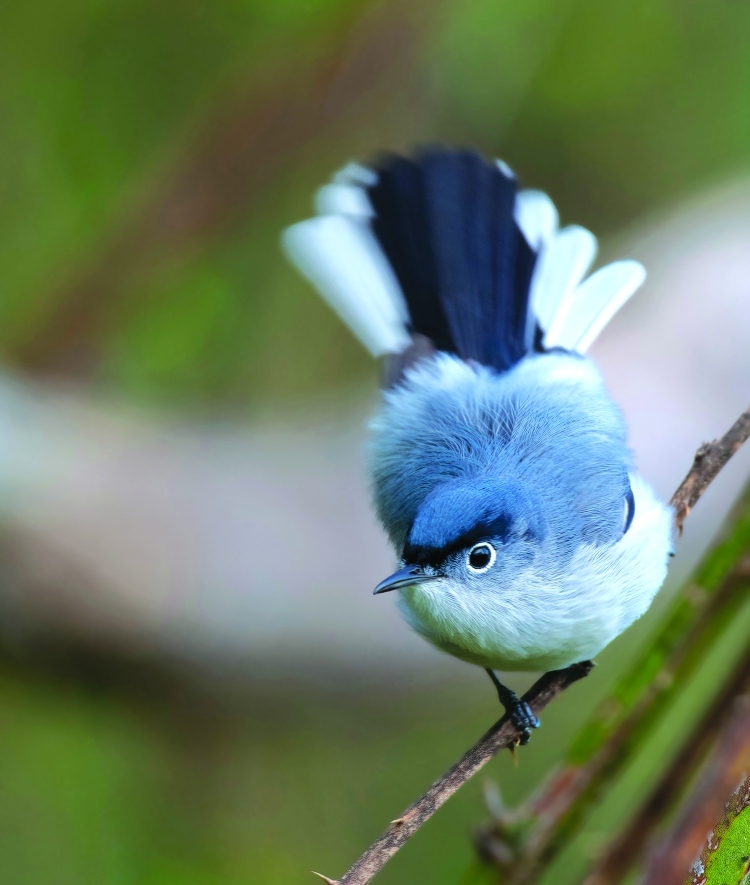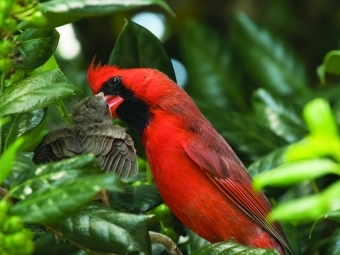For the Birds: Photographs Offer Glimpse of Campus Wildlife
July 5, 2022
- Photography
- Eric Keith

Carolina Wren
They rise early, chattering and singing, flitting busily from task to task. Some come alive late in the day, pulling all-nighters. They inhabit every nook and cranny of campus, but they are not college students–they are the birds that make Davidson College home and hunting ground.
Eric Keith honed his craft as a wildlife photographer by capturing images of birds, “the most interesting things” in his backyard. With a little help from “Bird Man” Jeffrey Roth ’12 and Max Rollfinkle ’21, Keith learned to identify his feathered subjects by name, sight and sound. Nearly five years later, his images render vividly the grace, beauty and diversity of birdlife on and nearby campus.
I immediately had a desire to get a DSLR of my own, and it was then that I discovered that my wife had an old Nikon sitting in the closet. I spent a day and a half on the back porch, alongside both of my brothers, taking photos of the only thing interesting in my backyard … birds.
“The photos help tell their life story and the joys and struggles that exist in their world,” he says. “It is this reason that I like to use my photography not only to see the beauty of nature, but to also educate people of the struggles these animals endure daily and what we can do to help.”
Keith generously provided a sample of his work (all images caught on campus) to inspire appreciation of the natural world in our own backyards, and in the hopes that others will be moved to conserve and protect our environment.

Northern Mockingbird

Blue-gray Gnatcatcher
Q&A with Eric Keith
In this Q&A, Keith shares more about his passion for photography and birding.
How did you come to be interested in nature photography, and bird photography in particular?
My brothers and I have always had a passion for taking pictures (for me mainly with a cell phone and cheap cameras), but I was introduced to proper photography equipment on Aug. 21, 2017, during the Great American Eclipse.
I met my family in Newberry, South Carolina, to view an eclipse in totality for the first time in my life. I came “prepared” with my cell phone and a $50 refurbished point-and-shoot camera, only to look foolish next to my oldest brother’s multiple DSLRs and telescope. I remember thinking that I’d get a decent shot at 1/100th of the cost!
After the eclipse, my family stayed at our house in Huntersville for a few days before heading back to Pennsylvania, so I had the opportunity to see my brother’s photos come to life. I was SO wrong thinking that my images would compare as I gazed in amazement at the level of detail in his photos. I immediately had a desire to get a DSLR of my own, and it was then that I discovered that my wife had an old Nikon sitting in the closet. I spent a day and a half on the back porch, alongside both of my brothers, taking photos of the only thing interesting in my backyard … birds.
At this stage, I knew what a Northern Cardinal or a Blue Jay was, but beyond that they were just birds to me. Soon after my family left, I found a great deal on an awesome DSLR but I still did not know what to focus my photography on yet. I remembered how fun and challenging it was to capture an image of a bird fluttering around my feeders, so I decided I’d focus on that. What happened was life changing.

Northern Cardinal
I immediately purchased a new lens long enough to get decent shots of the birds without disturbing them. I reached out to an old friend nicknamed the “Bird Man,” who was also the principal trumpet of the Davidson College Symphony Orchestra and a Davidson College alum. I’d called him once before to request an ID of a bird that woke us up every morning–he immediately identified the bird as an Eastern Towhee singing, “Drink your, teeeaaaa!” What a southern thing for a bird to say... Anyway, I spoke to this friend about my new found passion, and he introduced me to the world of birding.
With my new camera in hand, I joined him for a few birding trips and was hooked. Not only was it incredible to capture these creatures, it was incredible to, just for that moment, enter their worlds and observe their lives. The photos help to tell their life stories, and the joys and struggles that exist in their worlds. It is this reason that I like to use my photography not only to see the beauty of nature, but to also educate people of the struggles these animals endure daily and what we can do to help.
Not only was it incredible to capture these creatures, it was incredible to, just for that moment, enter their worlds and observe their lives.
What has made this passion become an everyday part of my life is the connection to my mother, who passed away nearly a decade ago. I always knew she liked birds because we had feeders at the house, and she collected just about anything that had birds on it, but I never knew she was a birder. There are a few differences between bird watchers and birders, and keeping a “life list” of observed birds is the most obvious sign that you are a true birder.
Soon after I developed my passion for bird photography, my father took me aside to show me my mother’s bird book. He flipped to the back to show me her hand-written life list of birds, and the connection to my mother hit me like a ton of bricks. To see that I have developed the same passion years later made me so happy and of course, to miss her even more. Now when I bird, I always think of my mother, and every once in a while I feel like she gifts me with a GREAT view of a spectacular bird.
I also realized that my father is more into birds than I ever knew, and he has recently started keeping his own life list, adding to the list that he helped my mother gather through the years. Now, both of my brothers are also birders, and like to photograph birds as well, but we each have our specialties. The icing on the cake is that I get to enjoy birding and bird photography with my amazing wife and my 2.5-year-old daughter, who not only can ID birds in the backyard, but also carries my mother’s name as her middle name.
What do you look/listen for when you are out with your camera? (movement, color, bird calls etc)
I would say 75% of birding is done with your ears. I think this is why musicians tend to make decent birders. My friend that got me into birding told me to really focus on learning calls. I’m so thankful for that advice, because now my ears are always open. This holds true for photographing birds, too. As soon as I hear a bird, I stop in my tracks (which often leads to collisions on the trail, sorry Tara) and I wait patiently to hear it again, get the positive ID, make visual contact, and wait for that moment to take the photos.
About 25% of the time I see movement or in some cases specific colors that stick out (like the red of a male Summer Tanager surrounded by green leaves). Visual birding/bird photography can drive you a bit crazy though, especially in the fall when brightly colored, bird-sized objects are constantly moving or falling. This is why I rely on my ears more than my eyes to detect birds. Listening to birds can lead to a specific ID on that species, but it can also lead you to birds that are being harassed. Many passerines scold raptors and can lead me to some great views of owls, hawks, falcons and so on.
And how have your powers of observation changed since you’ve been birding?
I feel like I’ve gained another sense since birding because what I observe in my surroundings has increased exponentially. I often have to dial it down, especially when driving, because I can be easily distracted by anything small and fast-moving.
Where is your favorite place on campus to bird watch?
The cross-country trails are the most fruitful, but I often like to walk campus and observe the large amount of birds just overhead in our beautiful trees. Many times I’ve witnessed students, staff, faculty, and the public walk within 10 feet of an owl, directly under a perched red-shouldered Hawk, or within an arm’s length of a perched Northern mockingbird. The rarest bird I’ve found on campus was in the trees right behind Sloan; a yellow-throated warbler.
What is your favorite bird, and why?
Depends on the day! Most often, it is the Carolina wren. This bird, often nicknamed the opera singer of the woods, has a huge variety of calls, is SUPER loud for its size, is always bouncing around and bobbing its head, and is often curious about the camera. I also have a family of Carolina wrens that have nested in my yard for years, and over the winter they like to roost in our wreath on the front door. This causes problems entering our house, because as we are trying enter they exit the wreath and scare the you-know-what out of us. I compromised with them by hanging a straw hut/roost above the door with their personal suet feeder. Now, every chilly evening I come home to one or two little tails poking out of the roost.
What is the one bird you’d like to photograph that you haven’t been able to photograph?
The snowy owl. Often found near open bodies of water (mainly the northeast coast) and in freezing temps, I’ve had very few opportunities to look for one. They are very challenging to photograph since they are all white and it’s easy to lose all detail (blowing out the whites they call it), so I look forward to the challenge. It’s been at the top of my list for the 4.5 years of my birding.
What is an interesting thing you’ve learned about birds since you’ve been photographing them?
I have so many topics I could cover here, but I’ll pick one that relates back to my music background. I never realized that birds need to practice their calls like I practice a certain passage from a symphony. Even fully mature birds can be found in the center of a dark bush, softly practicing their various calls. It gets even more entertaining when it’s a younger bird that hasn’t quite figured it out yet and sounds a bit… off. I find this to be one of the cutest things to experience.
What is required to do this kind of photography successfully?
To do this level of photography, you need the right equipment, a lot of patience, time, specific knowledge of birds (habitat, behavior, etc.), but most of all you need the passion. Without the passion, you will never have the patience, carve out the time, invest in the proper equipment, or take the time to study the birds. You also have to have respect for the animals, so you are not distracting them from going about their business of surviving and thriving.
What have you learned about yourself as you’ve grown as a photographer?
I have learned that I have been missing something crucial in my life for so long. I’ve always been a guy that hates to sit still, but birding and bird photography have forced me to be more observant, be patient, and take some time to sit still and relax. Birding is my meditation and will no doubt add years to my life.
Eric Keith is director of music production and promotion at the college and a member of the Davidson College Symphony Orchestra.
This article was originally published in the Spring/Summer 2022 print issue of the Davidson Journal Magazine; for more, please see the Davidson Journal section of our website.



